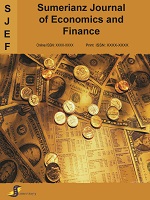Sumerianz Journal of Economics and Finance

Online ISSN: 2617-6947
Print ISSN: 2617-7641
Quarterly Published (4 Issues Per Year)
Journal Website: https://www.sumerianz.com/?ic=journal-home&journal=26Archive
Volume 3 Issue 6 (2020)
Determinants of Climatic Variability and Adaptation Strategies of Farming in Benue State Nigeria
Authors : Adeagbo Benjamin Akinkunmi
Abstract:The study examined ex-post evaluation of flooding impact in Benue State, Nigeria. The study used purposive, multi-stage random, and convenient sampling techniques to select 315 farmers whose farms have been affected by flooding. Cross-sectional and time-series data for the study were collected from both primary and secondary sources using structured questionnaires, interviews, journals, data from NIMET and publications from other relevant agencies like BNARDA. The data collected were analysed using descriptive statistics, Ordinary Least Square (OLS) Estimate, Maximum Likelihood Estimate (MLE).The mean age of the farmers in the study area is 47 years. The analysis of the gender indicates that farming activities are dominated by males. It was revealed that 79.0% of the household heads were married. Also, 45.7% of the farmers have primary school education, while only 28.5% (Secondary School holders) constitute lower mean averages in terms of educational qualifications. The household size in the study area showed 20.6% of the household size in the study area constituting (1-5) number of persons per household, 52.1% of the household size constituting (6-9) number of persons per household. This is lower than the average of 9 persons per household whose provision in the agricultural sector is significant, as reported by Irohibe and Agwu (2014), but could place greater burden on non-farming households. The trends of the climatic variables (especially rainfall) were significant on the yields of crops: Maize, Rice, Sorghum and Yam. These crops were selected for based on crops farmers grow predominantly in the area and by extension they were planted during excessive rainfall (flooding).This excessive rainfall led to SPIKES (a sharp rise in rainfall followed by a sharp decline),it was observed that the crop yields responded to the spikes which brought about lower yields in such years whose impact were felt in one or two more years after. The unit root and diagnostic tests were conducted on the time-series variables. Also, ARDL co-integration estimations were used to determine the effect of the long run on each of the variables. More so, the adaptation strategies that farmers used were examined and the Mean, Variation and Standard Deviation of these strategies and constraints encountered by farmers were analysed. In conclusion policy recommendations were made in order to proffer solution to some of these challenges.
Changes in Taiwan's Economy and Consumption After the End of the Epidemic
Authors : Li-Wei Lin ; Shih-Yung Wei ; Zhu-Ji ; Yun-Han Zhang
Abstract:This article examines the impact of 19-COVID-19 on Taiwan’s economy from the end of 2019 to June 2020. The epidemic has caused a huge impact on the sales of brick-and-mortar stores. Consumers are reluctant to buy products and consume abroad, including catering industry, tourism industry and transportation industry. We mainly investigated consumers’ purchase of physical stores and virtual stores, and found that consumers liked to sell and buy in virtual stores and platforms during the outbreak of the epidemic. In Taiwan, when the epidemic was about to end in late May and early June, consumers gradually changed from virtual stores to physical stores. Such a change can be seen that consumers have gradually changed from virtual stores to physical stores. This study mainly investigates the relevant factors such as consumers’ buying behavior, government policy incentives to stimulate consumption, and impulsive buying behavior change. We surveyed consumers with a sample size of 150 and recycled 123 copies. The main purpose is to investigate whether the difference in consumer satisfaction is caused by the epidemic. This study finds that the overall epidemic situation has a positive relationship with consumers’ buying behaviors, including online shopping during the epidemic and offline buying after the epidemic, which has a certain impact on consumers’ buying behaviors.



